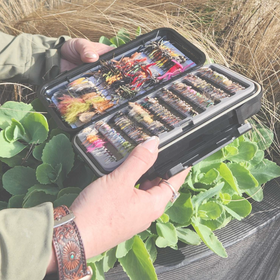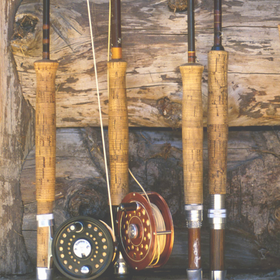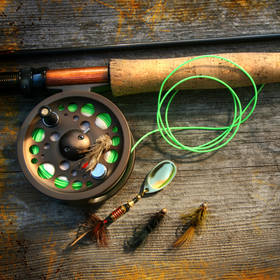To Shop Ants and other Terrestrials Click Here
Fly anglers are schooled at an early age, (well any age, I suppose, but early into their foray of fly fishing), about the big three: mayflies, caddisflies and stoneflies. I need to digress again, this is for trout anglers. If you began fly fishing for other species, you were probably schooled about other things. For trout fishermen, the importance of mayflies, caddis, and stoenflies are hit upon early, and re-learned repeatedly. With good reason for sure. These insects are of huge importance to most trout habitats, and their hatches provide spectacular fishing. But they are not exclusive to a trout's diet, and in some locales they make up a lesser portion than you might think.
 - A flying ant in the middle of it's mating season (photo: www.troutnut.com)
- A flying ant in the middle of it's mating season (photo: www.troutnut.com)Trout, like all fish, are opportunists. They feed on whatever is available. However, they do seem to have preferences for whatever reason. For example, many observers have noticed trout's propensity for hitting beetles. Biologists tell us beetles are loaded with protein, therefore trout perhaps know what is good for them, or maybe they just like the taste. Like beetles, trout also go wild for ants. In some locations, the mating of carpenter ants takes place at the same time as more well-known mayfly hatches, yet the observant angler readily switches to the ant pattern because trout hit these much more readily. Perhaps it is because they are not water borne, but more than likely there are other reasons. Some have claimed it is because during mating season, ants are filled with pheromones, and the smell attracts the fish.
 - Flying Ant patterns are popular and productive
- Flying Ant patterns are popular and productiveFlying ant migrations occur when the winged adult begins its mating cycle. At that time, hundred of thousands of these terrible fliers congregate around lakes, and they are not great at flying. Each colony will produce a huge abundance of these specialized ant, and the vast majority will end up not fulfilling its mission. Their ineptitude is the booty for trout and likewise trout anglers.
 - A big, black flying Carpenter Ant makes a great snack for a trout. (photo: www.troutnut.com)
- A big, black flying Carpenter Ant makes a great snack for a trout. (photo: www.troutnut.com)Weather also plays a huge part in ant populations, especially in the mountains. Warm winds push up the mountains, trapping swarms of ants around the lakes that are nestled into depressions in the mountains that provide relief from the warm winds. These are the conditions of the famed 'ant falls' of the Rockies, Sierras, and Cascades. A big ant fall is likely to occur on the first hot summer days.
On the Au Sable River, red ants take center stage in June. In British Columbia, it is the big black Carpenter Ants that hit center stage in June, followed by the red ants later in the summer. Each species and each locale follow slightly different protocol, but the result is the same, fish love ants so be prepared.
 - Parachute Ant is a great pattern that is easy to see.
- Parachute Ant is a great pattern that is easy to see.Many fly anglers will resort to ants when nothing else seems to be happening. Ants will fall into the water daily, and being opportunistic feeders, trout will gobble them up. So in a sense ants are always in season, and they are a decent choice wherever you might be. Fish them close to the bank, as ants live there, look for likely ant habitat including rotting logs. Lakes and rivers bordered by old growth are prime locations to cast the ant. Beavers also leave primary ant habitat in their wake.

While most seasoned trout anglers learn the conditions that lead to their favorite mayfly hatch, they often over look the 'ant hatch' occurring right under their nose. Careful observation and an expansion of your knowledge will lead to expansion of arsenal to trick your wily prey.




